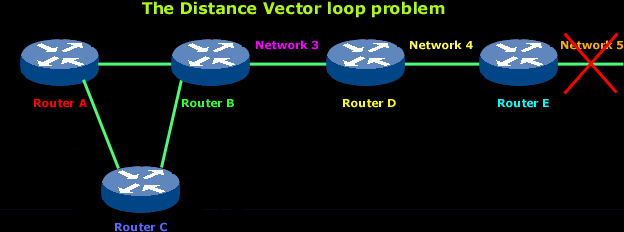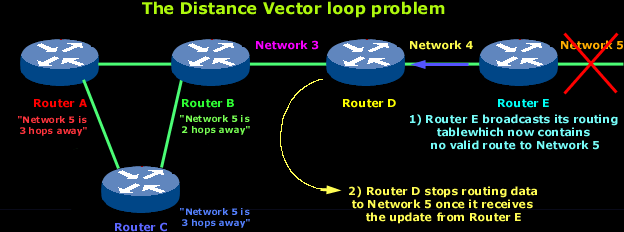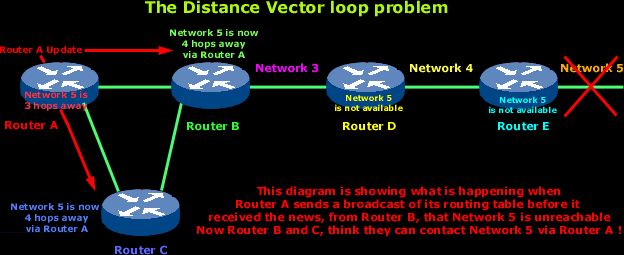Distance Vector
Routing Protocols
Introduction
Distance
Vector routing protocols use frequent broadcasts
(255.255.255.255 or FF:FF:FF:FF) of their entire routing
table every 30 sec. on all
their interfaces in order to communicate with their
neighbours. The bigger the routing tables, the more
broadcasts. This methodology limits significantly the
size of network on which Distance Vector can be used.
Routing Information Protocol (RIP)
and Interior Gateway Routing
Protocol (IGRP) are two very popular
Distance Vector routing
protocols. You can find links to
more information on these protocols at the bottom of the
page. (That's if you haven't had enough by the
time you get there !)
Distance Vector protocols
view networks in terms of adjacent routers and hop
counts, which also happens to be the metric used. The
"hop" count (max of 15 for RIP,
16 is deemed unreachable and 255
for IGMP), will increase by one every time the
packet transits through a router.
So the
router makes decisions about the way a packet will
travel, based on the amount of hops it takes to reach
the destination and if it had 2 different ways to get
there, it will simply send it via the shortest path,
regardless of the connection speed. This is known as
pinhole congestion.
Below is a
typical routing table of a router which uses
Distance Vector routing
protocols:

Let's explain what is happening here :
In the
above picture, you see 4 routers, each connected with
its neighbour via some type of WAN link e.g ISDN.
Now, when a
router is powered on, it will immediately know about the
networks to which each interface is directly connected.
In this case Router B knows
that interface E0
is connected to the
192.168.0.0 network and the
S0 interface is connected
to the 192.168.10.0
network.
Looking
again at the routing table for
Router B, the numbers you see on the right hand
side of the interfaces are the "hop counts" which, as
mentioned, is the metric that distance vector protocols
use to keep track on how far away a particular network
is. Since these 2 networks are connected directly to the
router's interface, they will have a value of zero (0)
in the router's table entry. The same rule applies for
every router in our example.
Remember we
have "just turn the routers on", so the network is now
converging and that means that there is no data being
passed. When I say "no data" I mean data from any
computer or server that might be on any of the networks.
During this "convergence" time, the only type of data
being passed between the routers is that which allows
them to populate their routing tables and after that's
done, the routers will pass all other types of data
between them. That's why a fast convergence time is a
big advantage.
One of the
problems with RIP is that
it has a slow convergence time.

Let's explain what we see :
In the
above picture, the network is said to have "converged",
in other words, all routers on the network have
populated their routing table and are completly aware of
the networks they can contact. Since the network is now
converged, computers in any of the above networks can
contact each other.
Again,
looking at one of the routing tables, you will notice
the network address with the exit interface on the right
and next to that is the hop count to that network.
Remember that RIP will only
count up to 15 hops, after which the packet is discarded
(on hop 16).
Each router will broadcast its entire routing table
every 30 seconds.
Routing
based on Distance Vector
can cause a lot of problems when links go up and down,
this could result in infinite loops and can also de-synchronise
the network.
Routing
loops can occur when every router is not updated close
to the same time.
Let's have
a look at the problem before we look at the various
solutions:

Let's explain :
In the
above picture you can see 5 routers of which
routers
A and B are
connected with Router C,
and they all end up connecting via routers
D and
E to Network 5.

Now as the
above picture shows, Network 5
fails.

All routers
know about Network 5 from
Router E. For example,
Router A, in its tables,
has a path to Network 5
through routers B,D
and E.
When
Network 5 fails,
Router E knows about it
since it's directly connected to it and tells
Router D about it on its
next update (when it will broadcast its entire routing
table). This will result in Router
D stopping routing data to
Network 5 through Router E.
But as you can see in the above picture, routers
A
B and
C don't know about
Network 5 yet, so they keep
sending out update information.
Router D will eventually send out its update and
cause Router B to stop
routing to Network 5, but
routers A and
C are still not updated. To
them, it appear that Network 5
is still available through Router
B with a metric of 3 !

Now
Router A sends its
regular broadcast of its entire routing table which
includes reachability for Network
5. Routers C and
B receive the wonderful
news that Network 5 can be
reached from Router A, so
they send out the information that
Network 5 is now available !
From now
on, any packet with a destination of
Network 5 will go to
Router A then to
Router B and from there
back to Router A (remember
that Router B got the good
news that
Network 5 is available via
Router A).
So this is
where things get a bit messy and you have that wonderful
loop, where data just gets passed around from one router
to another. Seems like they are playing ping pong :)
To deal
with these problems we use the following techniques:
Maximum Hop Count
The routing
loop we just looked at is called "counting to
infinity" and it is caused by gossip and wrong
information being communicated between the routers.
Without something to protect against this type of a
loop, the hop count will keep on increasing each time
the packet goes through a router ! One way of solving
this problem is to define a maximum hop count. Distance
Vector (RIP) permits a hop
count of up to 15, so anything that needs 16 hops is
unreachable. So if a loop occurred, it would go around
the network until the packet reached a hop count of 15
and the next router would simply discard the packet.
Split Horizon
Works on
the principle that it's never useful to send information
about a router back to the destination from which the
original packet came. So if for example I told you a
joke, it's pointless you telling me that joke again !
In our
example it would have prevented
Router A from sending the updated information it
received from Router B back
to Router B.
Route Poisoning :
Alternative to split horizon, when a router receives
information about a route from a particular network, the
router advertises the route back to that network with
the metric of 16, indicating that the destination is
unreachable.
In our
example, this means that when
Network 5 goes down, Router
E initiates router poisoning by entering a table
entry for Network 5 as 16,
which basically means it's unreachable. This way,
Router D is not susceptible
to any incorrect updates about the route to
Network 5. When
Router D receives a router
poisoning from Router E, it
sends an update called a poison reverse, back to
Router E. This make sure
all routes on the segment have received the poisoned
route information.
Route
poisoning, used with hold-downs
(see section below) will certainly speed up convergence
time because the neighboring routers don't have to wait
30 seconds before advertising the poisoned route.
Hold-Down Timers
Routers
keep an entry for the network-down state, allowing time
for other routers to recompute for this topology change,
this way, allowing time for either the downed router to
come back or the network to stabilise somewhat before
changing to the next best route.
When a
router receives an update from a neighbor indicating
that a previously accessible network is not working and
is inaccessible, the hold-down timer will start. If a
new update arrives from a neighbor with a better metric
than the original network entry, the hold-down is
removed and data is passed. But an update is received
from a neighbor router before the hold-down timer
expires and it has a lower metric than the previous
route, therefore the update is ignored and the hold-down
timer keeps ticking. This allows more time for the
network to converge.
Hold-down
timers use triggered updates, which reset the hold-down
timer, to alert the neighbor's routers of a change in
the network. Unlike update messages from neighbor
routers, triggered updates create a new routing table
that is sent immediatley to neighbor routers because a
change was detected in the network.
There are
three instances when triggered updates will reset the
hold-down timer:
1) The
hold-down timer expires
2) The
router received a processing task proportional to the
number of links in the internetwork.
3) Another
update is received indicating the network status has
changed.
In our
example, any update received by
Router B from Router A,
would not be accepted until the hold-down timer expires.
This will ensure that Router B
will not receive a "false" update from any routers that
are not aware that Network 5
is unreachable. Router B
will then send a update and correct the other routers'
tables.
Please
select the Distance Vector
protocol you want to read about:
Routing
Information Protocol - RIP
Interior Gateway Routing Protocol - IGRP |
